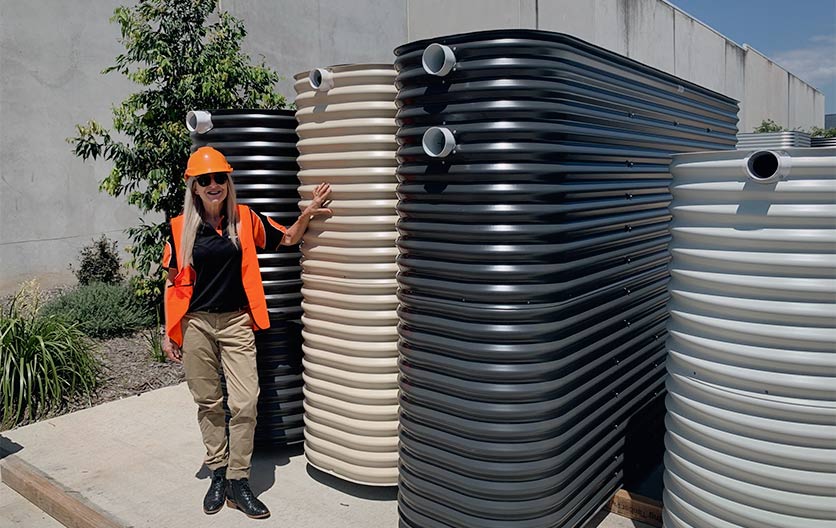Finest Slimline Water Tanks: Sturdy and Compact Water Storage Options
Finest Slimline Water Tanks: Sturdy and Compact Water Storage Options
Blog Article
Recognizing the Importance of Rain Storage Tanks in Drought-Prone Regions for Water Safety
In regions vulnerable to extended droughts, the function of rainwater storage tanks in bolstering water protection is a subject of expanding value. As communities face the challenges of water shortage, understanding the relevance of these tanks exceeds plain collection of rainwater. Rain containers act as an important device in mitigating the impact of water scarcities by supplying a sustainable source of water for numerous requirements. The true worth of rain tanks extends far past simple storage; it includes resilience-building procedures and the promotion of long-lasting water preservation strategies. This multifaceted approach to water safety warrants a closer evaluation of the duty rainwater storage tanks play in guaranteeing a dependable supply of water during times of dry spell.
Benefits of Rainwater Containers
Making use of rainwater storage tanks offers a lasting option for increasing water system and improving water security in household and commercial settings. Among the main benefits of rain containers is their capacity to reduce dependence on keys water supply. By recording and saving rainwater that falls on roofs, this alternative source can be utilized for numerous non-potable functions such as irrigation, purging bathrooms, and cleaning clothing. This not only preserves cured drinking water but likewise reduces water expenses for individuals.

Rain Harvesting Techniques
Rainwater gathering strategies incorporate a variety of methods created to successfully accumulate and store rain for different objectives, adding to water conservation and sustainability. One common strategy is the installment of rooftop catchment systems, where rain is collected from the roof of a structure and directed to a tank. This method is reasonably straightforward and cost-efficient. Another preferred strategy is using above-ground or below ground tank to store rain for later use. These storage tanks come in various sizes and products to suit different demands and can be linked to the existing pipes system for simple gain access to.

In addition, rain yards and absorptive sidewalks are innovative techniques that entail landscaping or paving surfaces in a means that allows rain to percolate into the ground, renewing groundwater books. Additionally, shape farming and terracing are agricultural methods that help record rainwater and prevent soil erosion in hilly surface. By implementing these varied rain harvesting strategies, communities can improve water security and durability in drought-prone regions while advertising sustainable water monitoring techniques.
Significance of Water Safety
Ensuring dependable accessibility to tidy and enough water sources is paramount for maintaining human wellness, economic growth, and ecological well-being. Water safety and security is a critical element of social strength, especially in areas prone to dry spells and water scarcity. Appropriate water safety includes different measurements, consisting of schedule, high quality, and access of water for residential, farming, commercial, and environmental requirements.
Water safety plays a critical duty in advertising public wellness by lowering the frequency of waterborne conditions and making sure cleanliness facilities. Financially, water safety and security is vital for agricultural efficiency, industrial procedures, and general economic development. Slimline water tanks. Furthermore, water safety and security is very closely connected to environmental sustainability, as it sustains ecological communities, biodiversity, and general ecological equilibrium.
In drought-prone areas, water protection go ends up being much more crucial due to the enhanced danger of water scarcities. Executing strategies like rain harvesting, water recycling, and effective water management techniques can significantly improve water security in these areas. By focusing on water protection, neighborhoods can much better withstand the influences of environment modification, populace growth, and various other difficulties that endanger water accessibility.
Enhancing Water Resilience
With enhancing international water challenges, check my reference building resilience in water supply has actually ended up being a critical emphasis for sustainable development efforts. Enhancing water resilience includes carrying out methods to make sure water accessibility and quality in the face of transforming ecological problems, such as droughts, floods, and contamination.
One key element of improving water resilience is advertising the usage of rainwater containers in drought-prone areas - Slimline water tanks. Rainwater tanks serve as an efficient methods of catching and storing rainwater for later usage, reducing reliance on scarce freshwater resources during dry durations. By incorporating rain harvesting systems right into water management plans, areas can boost their capacity to endure water shortage and maintain water safety

Sustainable Water Conservation
Amidst escalating water difficulties, the sensible management of water resources via sustainable conservation practices is necessary for making certain long-term ecological stability and social health. Sustainable water conservation entails the effective use water resources to satisfy present demands without endangering the ability of future generations to satisfy their own needs. By executing strategies such as rain harvesting, greywater recycling, and water-efficient innovations, neighborhoods can decrease water wastage and minimize pressure on freshwater resources.
Moreover, sustainable water conservation practices add to ecosystem health and wellness by keeping sufficient water degrees in rivers, lakes, and wetlands, sustaining biodiversity, and protecting natural environments. These techniques additionally play a critical function in mitigating my website the effects of climate modification by helping to adapt to altering precipitation patterns and water accessibility.

Conclusion
Finally, rainwater tanks play a critical duty in enhancing water safety and strength in drought-prone areas. By making use of rain harvesting techniques, communities can decrease their reliance on standard water resources and promote sustainable water conservation practices. This not only helps mitigate the influences of water deficiency throughout dry spells yet additionally adds to lasting water protection and strength despite environment modification difficulties.
Report this page